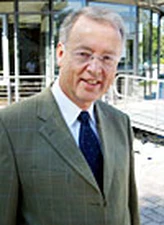Ulrich Schumann

The 2007 Lewis Fry Richardson Medal is awarded to Ulrich Schumann for his fundamental and pioneering work on the ‘realizibility’ of turbulence models and their wide application in geophysical flows, notably to establish through accurate simulation the chemical effects of aircraft emissions on the stratosphere.
Prof. Schumann’s research has led to important developments in the understanding and modelling of turbulence and atmospheric physics. His work is informed by a deep and original application of non-linear physics, which makes him a very worthy recipient of the L.F. Richardson Prize of the European Geophysical Society. As with all highly original scientists he developed new techniques to aid his research. Some of these have been widely adopted. His clear writing and lecturing has ensured that his contributions have become well appreciated and utilised world wide. Schumann’s research on techniques in turbulence is based on his development of numerical simulations. He contributed to improving subgrid scale parameterisation for Large Eddy numerical simulations, by developing the Smagorinski approach. For atmospheric flows, he showed how small scale eddies contribute to large scale motions through ‘back-scatter’ models and modelling small scale processes in particular those associated with stable stratification and drag/flux processes at the ground or at the atmospheric/ocean interface. With these innovations it has become possible to calculate many critical atmospheric flows and also chemical processes and patterns that affect local weather transport processes. He and his colleagues particularly demonstrated these techniques with their computations of atmospheric flows with convection and over hills where turbulence develops mean flows.
Schumann’s other important contribution to turbulence was to provide a rational criterion for statistical models. He found that in certain models predictions of the statistical moments of the fluctuating qualities (e.g. velocity, temperature, etc.) did not relate to each other as is mathematically necessary for any real variables. Clearly kinetic energy has to be positive but Schumann showed that these ‘realisability’ criteria significantly constrain the possible range of values of other covariances. His work has become a central principle for assessing existing models and in making new developments.
As he took on responsibilities for atmospheric physics at the DLR laboratories with its aircraft and satellite observing facilities, his own research began to focus more on the physics and chemistry of the troposphere and on the effects of emissions from aircraft engines. He focussed on the delicate process involving particles, radiation, turbulence mixing and cloud formation. His group helped to provide much of the data and models used in the IPCC reports on estimating the effects of aviation on climate change that are likely to become more important in the future. Schumann is involved in ensuring that excellent scientific research is being applied to critical environmental policy decisions.
